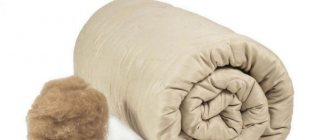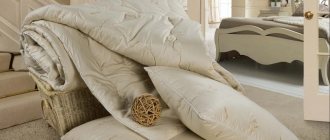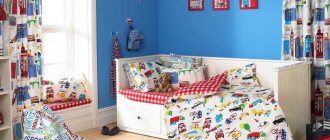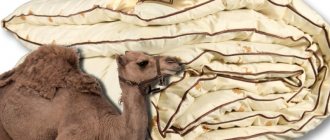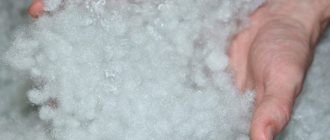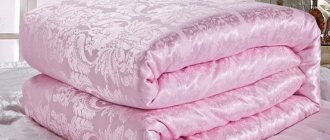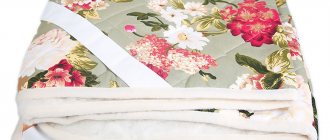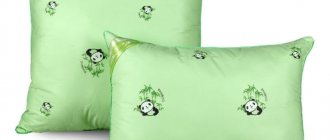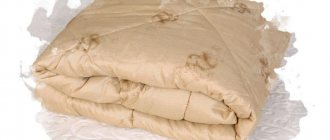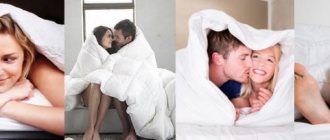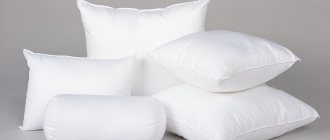Differences and criteria for choosing winter and summer blankets
For a restful, comfortable sleep, every piece of your bedroom wardrobe is important. The product should give warmth and comfort. In addition to the size, filling options and material of the cover, an important role is played by the purpose. The blanket can be summer or winter.
The selection criterion is the filler and its properties. This material is responsible for the degree of warmth. Which blanket filling is best depends largely on the season.
For the winter option, a group of materials is considered suitable: cotton wool, wool, down, cashmere, silk, bamboo. The filler density must be at least 300 g/m2. m. This indicator will provide warmth, but it is also necessary to take into account the physiological characteristics of a person.
For summer options, you can use a wide range of materials. It is important that the density indicator is from 200 to 400 g/sq.m. m. The region of residence matters. If in the southern regions a summer blanket can be replaced with a thin blanket or sheet, then in northern latitudes you will need a warm product.
Manufacturers use markings to indicate the degree of heat in the form of dots.
A blanket with the same filling may have different performance depending on the density of the filling.
There are five groups from 5 to 1 point according to the degree of warmth:
- 5 - winter (very warm), designated •••••;
- 4 (••••) - warm;
- 3 (•••) - all-season;
- 2 (••) - lightweight;
- 1 (•) - summer lung.
Prices: summary comparison table
| Brand name and blankets | Characteristics | Price, rub.) |
| 1. Togas Blanket “Lotus” | Type: light Size: 200 × 210 cm Filling: linen 60%, silk 40% Density: 250 g/m² Fabric: 100% cotton – jacquard | 13 590 |
| 2. Askona “Cool Max” | Type: all-season Size: 200 × 220 cm Filling: polyester Cover fabric: 100% cotton | 9 990 |
| 3. IKEA Fjällbräkka | Type: lightweight Size: 150 × 200 cm Filling: duck down – 60%, duck feather – 40% Filling weight: 315 g Total weight: 1325 g Fabric: 100% cotton | 4 999 |
| 4.Lonax "BLUE OCEAN" | Size: 170 × 205 cm Filling: swan down – 50%, natural cotton – 50% Density: 200 g/m² Fabric: microfiber | 2 025 |
| 5. Lounger blanket “Linen and Cotton” | Type: lightweight Size: 140 × 205 m Filling: linen, cotton Density: 150 g/m² Fabric: 100% cotton | 3 500 |
| 6. Goldtex “Merino Collection” | Type: lightweight Size: 172 × 205 cm Density: 150 g/m² Filling: sheep wool – 70%, polyester – 30% Fabric: cotton 100% | 4 380 |
| 7. Sortex “Bamboo Dream” | Type: lightweight Size: 220 × 200 cm Filling: bamboo Density: 150 g/m² Fabric: polyester | 1 650 |
| 8. Kariguz blanket “Bio Tencel” | Type: summer Size: 150 × 200 cm Fabric: Tencel Filling: lyocell (eucalyptus cellulose fiber) Density: 100 g/m² | 10 350 |
| 9. OL-tex blanket “Camel hair” | Type: lightweight Size: 170 × 205 cm Filling: camel hair 60%, polyester 40% Density: 200 g/m² Fabric: teak 100% | 3 180 |
| 10. Dargez blanket “Sydney” | Type: lightweight Size: 140 × 205 Filling: eucalyptus Filling weight: 740 g Fabric: microfiber 100% | 1 964 |
A properly selected summer blanket provides a person with quality rest and the ability to quickly fall asleep. Some consumers believe that in the heat it is enough to cover themselves with a sheet. However, sleeping under a blanket is healthier and more comfortable for at least three reasons:
- The blanket helps the body regulate and maintain optimal temperature.
- We feel calmer and happier thanks to serotonin, its amount begins to increase after sheltering.
- A feeling of safety and security appears, the person falls asleep faster.
Types of fillers
Blankets are classified by type:
- Natural fillers of animal origin.
- Natural herbal.
- Synthetic.
Each group is divided by type of raw material:
- Down of waterfowl.
- Sheep, camel wool, cashmere (mountain goat fluff).
- Cotton.
- Bamboo.
- Silk.
- Synthetic materials (sintepon, holofiber, synthetic fluff, silicone).
- Exotic (algae, eucalyptus, etc.).
An analysis of the characteristics of the fillers will tell you how to choose the right blanket. Let's take a closer look at the pros and cons.
Fabric for the cover
Fabric for a blanket, which is better:
- Duvet, how to choose fabric: you need a material with a dense weave that does not release down and feathers. It is impregnated with a special solution.
- It is better to choose a thick, cotton cover for the blanket if it is made of wool. Percale, twill, teak are suitable.
- Thin, delicate materials – cambric, satin – are suitable for a down product or one with underfur.
- For silk, a cover made of thick cotton or silk is suitable. These threads go well together. Satin jacquard weave fabric is suitable.
The inner and outer material must be combined for the product to last a long time.
Natural
The basis of natural fillers are natural raw materials: plant or animal. All types of materials are environmentally friendly, but some of them can cause allergic reactions. Popular fillers of animal origin are down, wool, and silk.
Plant materials include bamboo and cotton.
Bird fluff
Duck and goose down fillings are affordable, but heavier than eider down. The service life of such blankets is long - from 15 to 20 years. It is comfortable to sleep under them, but this option may not be suitable for people prone to allergies.
Advantages of down fillings:
- light weight;
- high degree of warmth;
- absorb moisture well;
- durability.
The disadvantages include:
- special care;
- allergic reactions.
An ideal winter blanket, it protects well from the cold. However, it is not suitable for people who tend to sweat. Down quickly absorbs moisture, but does not release it well.
Pay attention to the composition. If there is a feather in it, then its content should not exceed 15%, otherwise the product will be prickly and uncomfortable.
In addition to poultry, animal down is used to fill blankets: cashmere goats, merino, camel. The raw materials have good performance properties and high thermal insulation.
Sheep's wool
Eco-friendly material - sheep wool is used in the production of blankets for making blankets and as a filler. Both options are ideal for winter.
Unlike down-filled blankets, wool blankets are less voluminous but heavier. Care is simple, you can wash them in the machine, choosing the “gentle mode”. Unlike duvets made from sheep's wool, they retain dry heat better.
Advantages of the filler:
- easy care;
- thermal insulation;
- air conductivity;
- hygroscopicity;
- massage effect;
- service life 10 – 15 years.
Of the minuses it should be noted:
- sheepskin is attractive to moth larvae;
- ability to cause allergic reactions.
A blanket with sheep wool is suitable for the winter season; blankets made from this material belong to the all-season group.
Camel's wool
Camel wool and down are used as a filler for universal blankets and for making rugs. The material is environmentally friendly. Its properties are similar to sheep's, but the filler has less weight due to the voids in the fiber structure; Warms in winter and protects from overheating in summer.
Advantages:
- light weight;
- seasonality: ability to maintain body temperature;
- wear resistance;
- service life from 15 to 30 years with proper care;
- does not create a greenhouse effect due to good air conductivity;
- hygroscopic: easily absorbs and quickly removes moisture;
- dimensional stability (does not roll off after washing);
- ease of care;
- does not accumulate static electricity;
- unlike sheep wool, it has the ability to repel dirt;
- has healing qualities.
Flaws:
- attractive to dust mites;
- instability to bacteria;
- itchy, needs a quality duvet cover and cover;
- high cost justified by the durability of the product;
- may cause allergies.
When it comes to the question of which blanket is better, camel or sheep, an individual approach is required. Camel wool is lighter, sheep wool is heavy and can cake.
Bamboo
Bamboo blankets appeared relatively recently, but have become popular due to their environmental friendliness and hypoallergenicity. Important! Raw materials processed mechanically are considered natural. The fibers are called “bamboo flax”.
The filler is suitable for autumn, spring and summer. People who get very cold may find such blankets too light and cold.
This fiber has enough advantages:
- hygienic: odorless and does not absorb dust, does not accumulate dust;
- thermoregulation;
- hygroscopicity;
- actively releases accumulated moisture and dries quickly;
- ease;
- free air circulation;
- fiber blankets retain color brightness;
- not electrified;
- hypoallergenic;
- antiseptic properties: promotes the death of harmful microorganisms;
- beneficial effects on the skin.
The disadvantages include:
- low thermal insulation;
- tendency to wrinkle;
- short service life (from 1 to 3 years).
Eucalyptus (tencel, lyocell)
Eucalyptus fiber is an environmentally friendly natural material. A safe organic solvent is used to process wood, while the beneficial properties are preserved.
Filling made from eucalyptus raw materials is used in the production of three types of blankets: universal, summer and winter. They vary in thickness and density:
- universal models - 200 g/sq.m. m.;
- summer - 100 g/sq.m. m.;
- winter - 300 g/sq.m. m.
Eucalyptus filler has many advantages:
- hypoallergenic;
- no odor;
- retains its shape;
- does not accumulate dust;
- not electrified;
- the porous structure of the fibers promotes good air conductivity and hygroscopicity;
- suitable for people with excessive sweating;
- repels dust mites;
- unattractive to bacteria and insects;
- ease of care (machine washable);
- has antibacterial properties;
- due to the content of essential oils it has a healing effect;
- suitable for adults and children;
- service life of 10 years without losing the external attractiveness of the product.
The only disadvantage of eucalyptus blankets is their high cost.
Cotton
Modern cotton filling should not be confused with cotton wool. It is produced by combing out the fibers, bonding them with a special solution to give elasticity and lightness. The raw material is safe for health; non-woven fabrics are made from it.
Advantages of blankets with cotton filling:
- environmental friendliness;
- does not cause allergic reactions;
- ease;
- softness;
- hygroscopicity, ability to remove up to 20% moisture;
- air conductivity;
- strength and wear resistance;
- ease of care;
- affordable price.
There is only one drawback to cotton filling: it is not recommended to wash the product frequently.
Linen
Flax fiber is used to produce bedding. The cost of the blanket is high, but considering the ratio of pros and cons, it is justified. The service life of sleeping items with linen filling is 5 – 7 years.
Pros:
- environmental friendliness;
- strength and wear resistance;
- optimal thermoregulation;
- high hygroscopicity - absorbs up to 12% moisture, quickly removes and remains dry;
- does not absorb odors;
- repels dust;
- does not accumulate static electricity;
- retains its shape;
- neutralizes the electromagnetic field;
- has a beneficial effect on well-being;
- helps strengthen the immune system;
- does not shrink.
Disadvantages of the filler:
- demanding care;
- high price.
Silk
Silk has always been considered a high-status material with high value. Important! High-quality silk blanket is made in China. Silkworm fibers are not suitable for transportation.
The types of fibers are divided into two types:
- Mulberry, considered elite. Lightweight with high thermal conductivity.
- Tussa is a budget option, coarser and heavier than the Mulberry variety.
Benefits of silk fillers:
- softness and tenderness;
- ease;
- hypoallergenic;
- environmentally friendly raw materials;
- increased thermoregulation: warms in winter, cools when it’s hot;
- excellent air circulation;
- high hygroscopicity: absorbs up to 30% of moisture from its own weight, evaporates it and remains dry;
- Seracin protein in the fiber has bactericidal properties;
- repels dust;
- service life 12 – 15 years;
- not electrified.
Disadvantages to consider:
- high price;
- requires delicate handling and care;
- not everyone likes the sliding surface;
- difficult to distinguish from a fake.
Manufacturers
Rating of companies making blankets:
- The ranking is topped by the well-known Shchigrov down and feather factory, Belashoff. She produces a variety of bed textiles.
- One of the popular brands is CLEO. The types of blankets and other bedding items are constantly being updated. All products comply with international quality standards and have all the necessary certificates.
- Medium-priced ComfortLine textiles are made from a good cotton base. Imported materials.
- Primavelle - the best eco-friendly products with beautiful designs.
- Silk varieties of Chinese origin are represented in Russia by the company Southern Path. They have all the necessary certificates.
- Average prices from the manufacturer Verossa. There are options with a variety of fillings - bamboo, algae, swan fluff, camel hair.
These are the best blanket manufacturers with a large assortment and good quality.
Reviews:
Valeria, 53 years old: I have had a camel blanket for almost 20 years. It is thick and warms well in winter. When I lie under it, my back stops hurting.
Anton, 27 years old: I sleep under down all year round. It’s cold at home, even in summer I can’t stay warm without my favorite blanket. But in the summer I sweat a lot under it.
Karina, 31 years old: constant allergies prevent me from using anything other than synthetics. But I’m thinking of trying bamboo, they say it helps with allergies.
Vasily, 48 years old: I sleep like in childhood, under a flannelette blanket. I have a thin one, so in winter I tuck two into the duvet cover at once. But I don’t like synthetics, it’s hot and uncomfortable.
For a comfortable sleep, you need to choose the right bedding. The bedspread will give you a pleasant sleep or prevent you from getting a good night's sleep.
© 2021 textiletrend.ru
Synthetic
Fillers created by the synthesis of chemicals have a lower cost than natural ones. Depending on the type and methods of care, they have different service lifes. Do not cause allergies. Fillings for blankets of different seasons, including universal ones, are made from synthetic fibers.
These fillers are safe for allergy sufferers. Unlike natural fibers, synthetic fibers allow air to pass through worse and are less thermally conductive.
swansdown
Thinsulate, or swan down, is an artificial filler that exhibits properties similar to natural ones (volume and lightness). The difference lies in the low ability to retain heat. Such blankets are off-season.
Benefits of Thinsulate:
- hypoallergenic;
- unattractive to pests and bacteria;
- lightness: the weight of a blanket made from it is 0.5 kg;
- the ability to maintain shape due to the elasticity and resilience of the fibers;
- ease of care.
It is necessary to pay attention to the disadvantages:
- the material is not hygroscopic - its ability to absorb moisture is zero;
- not breathing;
- accumulates static electricity.
Thinsulate blankets are not suitable for people who sweat and should not be used on young children. Due to the properties of the material, there is a risk of overheating.
Polyester fiber
The fibers used to make polyester fillers are produced in four ways. Each class has 4-6 varieties, differing in particle size. The following polyesters are used as fillers:
- Siliconized hollow highly crimped.
- Regular.
Low grade polyester fibers are not suitable for making bedding. Examples of fillers: microfiber, ecofiber, etc.
All materials in this group are similar in properties. The differences between them are not significant. Advantages of polyester fillers:
- ease;
- the ability to retain heat due to the structure of the fibers;
- ease of care;
- elasticity;
- long service life (8 – 10 years).
The disadvantages include the following qualities:
- do not conduct air;
- do not absorb moisture;
- accumulate static electricity.
Holofiber
Holofiber is a polyester filler that is practical and functional. The structure of the fiber is hollow, resembling the properties of a spring. In the line of synthetic materials, it has gained popularity due to its ability to thermoregulate.
The advantages of holofiber include:
- ability to breathe;
- does not cause allergies;
- removes excess moisture;
- has good thermoregulation;
- antistatic properties;
- ease of care;
- fiber elasticity;
- wear resistance;
- does not support combustion;
- lightness, softness;
- affordable price.
Minuses:
- elasticity and lightness are lost over time;
- after washing, loss of shape is possible, the filler begins to cake;
- Some people find it hot to sleep under such a blanket.
Sintepon
Sintepon is a budget filling option. Its service life is 5 – 7 years. Blankets with padding polyester filling have the ability to retain heat and are not afraid of the cold underneath. They remain elastic for a long time.
The advantages include:
- heat-saving properties;
- elasticity;
- health safety (for example, for filling children's sleeping items);
- affordable price.
Minuses:
- cheap samples may use glue that causes allergic reactions;
- low heat and air conductivity;
- not hygroscopic;
- unsuitable for harsh winters.
Thinsulate
Thinsulate was produced as an alternative to natural down. Their properties are largely similar. The second name is synthetic fluff, “swan fluff”. The filler is lightweight and elastic.
But unlike natural down, it is non-hygroscopic, electrified, does not breathe, and its ability to retain heat is much lower.
For any season
When choosing a blanket, you should pay attention to the degree of warmth that manufacturers promise . The most conscientious of them indicate it on the label. Usually this is an icon in the form of five dots: the more of them are filled in, the warmer the blanket. But usually the level of warmth is a subjective concept, so it is best to focus on your personal feelings.
Ideally, a household has not one blanket, but at least two - for different seasons. But there may also be one, consisting of two parts connected by buttons: a very convenient modern option for winter and summer. And when choosing a blanket, you must not forget that to a certain extent how well you can sleep depends on it. And in the modern rhythm of life, an extra sense of comfort will not hurt.
What to consider before buying a blanket
How to choose a blanket so that it lasts a long time, is practical and comfortable? First you need to determine the seasonality of the sleeping item, then the desired filling. Criteria that are important in this regard:
- Ease.
- Form.
- Softness.
- Case.
- Insulation quality.
- Firmware.
It is worth paying attention to the presence of odor.
Types of tailoring
Thanks to the type of sewing, the blanket gains the ability to retain heat by distributing the filler. Options:
- Quilted is a practical look. Makes it easier to care for the product.
- Karostep is a quilted blanket. The patterned stitch has a beautiful appearance. Blankets quilted in this way wear out faster than classic ones.
- Cassette is an expensive option. Thanks to it, an equal amount of filler is distributed in each cell. This technology prevents caking and knocking.
We take into account the sizes
Which blanket is the best size will be determined by the dimensions of the furniture and individual characteristics. Children's models are chosen for infants and toddlers. For an older child - a teenage or single blanket.
For a person who sleeps restlessly, it is better to choose a double or European standard. The same option is suitable for a married couple. For people who sleep peacefully, a one-and-a-half-size blanket is sufficient.
Cover fabric
The following requirements are imposed on the fabric of the covers: breathability, density, softness and elasticity. The following materials are suitable for this: linen, calico, satin and teak.
You should not choose covers made of synthetic fabrics. In addition to poor air conductivity, they do not have antistatic properties.
Thickness of blankets depending on the season
By density, taking into account the season, they are selected according to the following indicators:
- 100 gsm m. for summer;
- 200 gsm m for all-season models;
- 300 gsm m. for winter.
Quilted or cassette
In this matter, the type of filler plays an important role. For example, a classic stitch is unacceptable for down. It is better to choose the cassette version of the firmware.
Which blanket is best to choose depends on the filling. It is recommended to choose the cassette option for fibers prone to tangling.
Rules of care
To begin with, we list the general rules for all blankets, regardless of the type of filler:
- the blanket must be ventilated regularly;
- also whisk regularly so that the filler does not clump or clump;
- Be sure to use a duvet cover for protection.
Blankets with synthetic filling can be washed at home in the washing machine. Most natural fillers require dry cleaning. It is important not to store such products in sealed packaging for a long time.
The article was written for the site.
Tags:Bed, Bedroom
